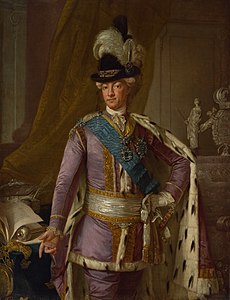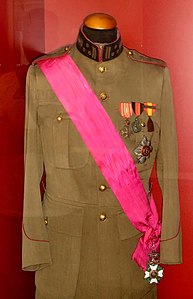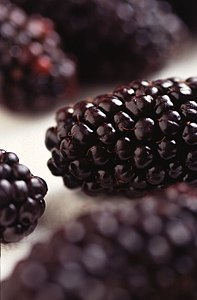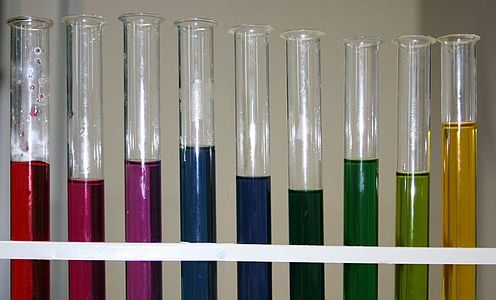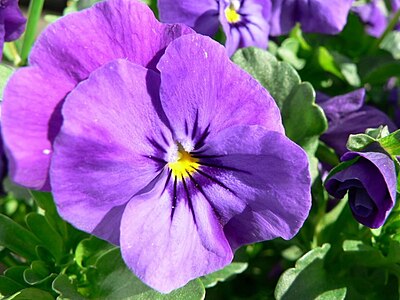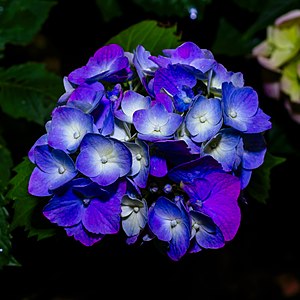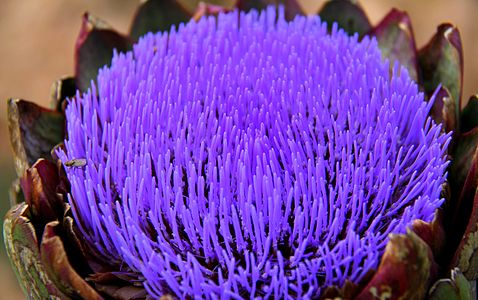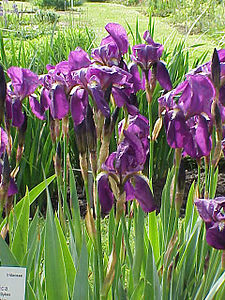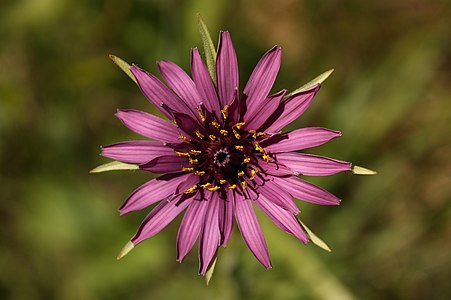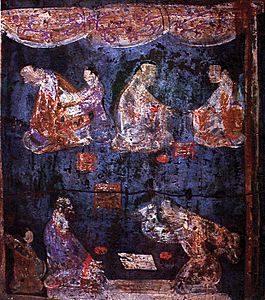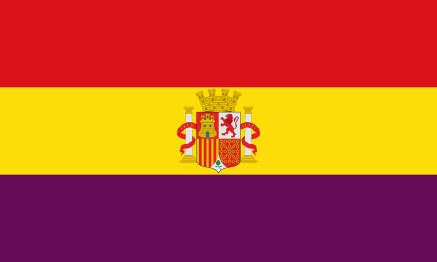Purple
| Purple | |
|---|---|
| Hex triplet | #800080 |
| sRGBB(r,g,b) | (128, 0, 128) |
| HSV(h,s,v) | (300°, 100%, 50%) |
| CIELChuv(L,C,h) | (30, 68, 308°) |
| Source | HTML color names |
| B:Normalized to [0–255] (byte) H:Normalized to [0–100] (hundred) | |
Purpleis acolorsimilar in appearance tovioletlight. In theRYB color modelhistorically used in the arts, purple is asecondary colorcreated by combining red and blue pigments. In theCMYK color modelused in modern printing, purple is made by combining magenta pigment with either cyan pigment, black pigment, or both. In theRGB color modelused in computer and television screens, purple is created bymixingred and blue light in order to create colors that appear similar to violet light.
Purple has long been associated with royalty, originally becauseTyrian purpledye—made from the secretions of sea snails—was extremely expensive in antiquity.[1]Purple was the color worn by Roman magistrates; it became the imperial color worn by the rulers of theByzantine Empireand theHoly Roman Empire,and later by Roman Catholicbishops.Similarly inJapan,the color is traditionally associated with theemperorand aristocracy.[2]
According to contemporary surveys in Europe and the United States, purple is the color most often associated with rarity, royalty, luxury, ambition, magic, mystery,pietyand spirituality.[3][4]When combined withpink,it is associated witheroticism,femininity,andseduction.[5]
Etymology and definitions
The modern English wordpurplecomes from theOld Englishpurpul,which derives fromLatinpurpura,which, in turn, derives from theGreekπορφύρα(porphura),[6]the name of theTyrian purpledyemanufactured in classical antiquity from a mucus secreted by thespiny dye-murexsnail.[7][8]The first recorded use of the wordpurpledates to the late 900s AD.[7]
In art, history, and fashion
In prehistory and the ancient world: Tyrian purple
Purple first appeared in prehistoric art during the Neolithic era. The artists ofPech Merlecave and otherNeolithicsites in France used sticks ofmanganeseandhematitepowder to draw and paint animals and the outlines of their own hands on the walls of their caves. These works have been dated to between 16,000 and 25,000 BC.[9]
Purple textiles, dating back to the early second millennium BCE, were found inSyria,making them the oldest known purple textiles in the world. These findings include textiles from a burial site inChagar Bazar,dating back to the 18th-16th centuries BCE, as well as preserved textile samples discovered in gypsum at the Royal Palace ofQatna.[10][11][12]
As early as the 15th century BC the citizens ofSidonandTyre,two cities on the coast of AncientPhoenicia(present day Lebanon), were producing purple dye from a sea snail called thespiny dye-murex.[13]Clothing colored with the Tyrian dye was mentioned in both theIliadofHomerand theAeneidofVirgil.[13]The deep, rich purple dye made from this snail became known as Tyrian purple.[14]
The process of making the dye was long, difficult and expensive. Thousands of the tiny snails had to be found, their shells cracked, the snail removed. Mountains of empty shells have been found at the ancient sites of Sidon and Tyre. The snails were left to soak, then a tiny gland was removed and the juice extracted and put in a basin, which was placed in the sunlight. There, a remarkable transformation took place. In the sunlight the juice turned white, then yellow-green, then green, then violet, then a red which turned darker and darker. The process had to be stopped at exactly the right time to obtain the desired color, which could range from a bright crimson to a dark purple, the color of dried blood. Then either wool, linen or silk would be dyed. The exact hue varied between crimson and violet, but it was always rich, bright and lasting.[15]
Tyrian purple became the color of kings, nobles, priests and magistrates all around the Mediterranean. It was mentioned in theHebrew Bible(Old Testament); in theBook of Exodus,God instructsMosesto have theIsraelitesbring him an offering including cloth "of blue, and purple, and scarlet,"[16]to be used in the curtains of theTabernacleand the garments of priests. The term used for purple in the 4th-centuryLatin Vulgateversion of the Bible passage ispurpuraor Tyrian purple.[17]In theIliadofHomer,the belt ofAjaxis purple, and the tails of the horses of Trojan warriors are dipped in purple. In theOdyssey,the blankets on the wedding bed ofOdysseusare purple. In the poems ofSappho(6th century BC) she celebrates the skill of the dyers of the Greek kingdom ofLydiawho made purple footwear, and in the play ofAeschylus(525–456 BC), QueenClytemnestrawelcomes back her husbandAgamemnonby decorating the palace with purple carpets. In 950 BC,King Solomonwas reported to have brought artisans from Tyre to provide purple fabrics to decorate theTemple of Jerusalem.[18]
Alexander the Great(when giving imperial audiences as thebasileusof theMacedonian Empire), the basileus of theSeleucid Empire,and thekings of Ptolemaic Egyptall wore Tyrian purple.
The Roman custom of wearing purpletogasmay have come from theEtruscans;an Etruscan tomb painting from the 4th century BC shows a nobleman wearing a deep purple and embroidered toga.
In Ancient Rome, theToga praetextawas an ordinary white toga with a broad purple stripe on its border. It was worn by freeborn Roman boys who had not yet come of age,[19]curule magistrates,[20][21]certain categories of priests,[22]and a few other categories of citizens.
TheToga pictawas solid purple, embroidered with gold. During theRoman Republic,it was worn by generals in theirtriumphs,and by thePraetor Urbanuswhen he rode in the chariot of the gods into the circus at theLudi Apollinares.[23]During the Empire, thetoga pictawas worn by magistrates giving publicgladiatorialgames, and by theconsuls,as well as by the emperor on special occasions.
During the Roman Republic, when a triumph was held, the general being honored wore an entirely purple toga bordered in gold, and Roman Senators wore a toga with a purple stripe. However, during theRoman Empire,purple was more and more associated exclusively with the emperors and their officers.[24]Suetonius claims that the early emperorCaligulahad theKing of Mauretaniamurdered for the splendour of his purple cloak, and thatNeroforbade the use of certain purple dyes.[25]In the late empire the sale of purple cloth became a state monopoly protected by the death penalty.[26]
According to theNew Testament,Jesus Christ,in the hours leading up tohis crucifixion,was dressed in purple (πορφύρα:porphura) by the Roman garrison to mock his claim to be 'King of the Jews'.[27]
The actual color of Tyrian purple seems to have varied from a reddish to a bluish purple. According to the Roman writerVitruvius,(1st century BC), themurexshells coming from northern waters, probablyBolinus brandaris,produced a more bluish color than those of the south, probablyHexaplex trunculus.The most valued shades were said to be those closer to the color of dried blood, as seen in the mosaics of the robes of theEmperor JustinianinRavenna.The chemical composition of the dye from the murex is close to that of the dye fromindigo,and indigo was sometimes used to make a counterfeit Tyrian purple, a crime which was severely punished. What seems to have mattered about Tyrian purple was not its color, but its luster, richness, its resistance to weather and light, and its high price.[28]
In modern times, Tyrian purple has been recreated, at great expense. When the German chemist Paul Friedander tried to recreate Tyrian purple in 2008, he needed twelve thousand mollusks to create 1.4 ounces of dye, enough to color a handkerchief. In the year 2000, a gram of Tyrian purple made from ten thousand mollusks according to the original formula cost two thousand euros.[29][30]
China
In ancient China, purple was obtained not through the Mediterranean mollusc, butpurple gromwell.The dye obtained did not easily adhere to fabrics, making purple fabrics expensive. Purple became a fashionable color in thestate of Qi( tề, 1046 BC–221 BC) because its ruler,Duke Huan of Qi,developed a preference for it. As a result, the price of purple fabric was over five times that of plain fabric. His minister,Guan Zhong( quản trọng ), eventually convinced him to relinquish this preference.
China was the first culture to develop a synthetic purple color.[31]
An old hypothesis suggested links between the Chinese purple and blue andEgyptian blue,however, molecular structure analysis and evidence such as the absence of lead in Egyptian blue and the lack of examples of Egyptian blue in China, argued against the hypothesis.[32][33]The use of quartz, barium, and lead components inancient Chinese glassand Han purple and Han blue has been used to suggest a connection between glassmaking and the manufacture of pigments,[34]and to prove the independence of the Chinese invention.[32]Taoistalchemistsmay have developed Han purple from their knowledge of glassmaking.[32]
Lead is used by the pigment maker to lower the melting point of the barium in Han Purple.[35]
Purple was regarded as a secondary color in ancient China. In classical times, secondary colors were not as highly prized as the five primary colors of the Chinese spectrum, and purple was used to allude to impropriety, in contrast to crimson, which was deemed a primary color and symbolized legitimacy. Nevertheless, by the 6th century AD, purple was ranked above crimson. Several changes to the ranks of colors occurred after that time.
-
An Egyptian bowl colored with Egyptian blue, with motifs painted in dark manganese purple. (between 1550 and 1450 BC)
-
Painting of a man wearing an all-purpletoga picta,from anEtruscantomb (about 350 BC).
-
Roman men wearingtogae praetextaewith reddish-purple stripes during a religious procession (1st century BC).
-
Different purple hues obtained from three types of sea snails
-
Dye bath of Tyrian purple
-
Cloth dyed with Tyrian purple. The color could vary from crimson to deep purple, depending upon the type ofmurexsea-snail and how it was made.
Purple in the Byzantine Empire and Carolingian Europe
Through the early Christian era, the rulers of theByzantine Empirecontinued the use of purple as the imperial color, for diplomatic gifts, and even for imperial documents and the pages of the Bible.Gospelmanuscriptswere written in gold lettering onparchmentthat was colored Tyrian purple.[36]Empresses gave birth in the Purple Chamber, and the emperors born there were known as "born to the purple," to separate them from emperors who won or seized the title through political intrigue or military force. Bishops of the Byzantine church wore white robes with stripes of purple, while government officials wore squares of purple fabric to show their rank.
In western Europe, the EmperorCharlemagnewas crowned in 800 wearing a mantle of Tyrian purple, and was buried in 814 in a shroud of the same color, which still exists (see below). However, after the fall ofConstantinopleto theOttoman Turksin 1453, the color lost its imperial status. The great dye works of Constantinople were destroyed, and graduallyscarlet,made with dye from thecochinealinsect, became the royal color in Europe.[37]
-
A medieval depiction of the coronation of the EmperorCharlemagnein 800. The bishops and cardinals wear purple, and the Pope wears white.
The Middle Ages and Renaissance
In 1464,Pope Paul IIdecreed that cardinals should no longer wear Tyrian purple, and instead wear scarlet, fromkermesand alum,[38]since the dye from Byzantium was no longer available. Bishops and archbishops, of a lower status than cardinals, were assigned the color purple, but not the rich Tyrian purple. They wore cloth dyed first with the less expensiveindigoblue, then overlaid with red made fromkermesdye.[39][40]
While purple was worn less frequently by Medieval andRenaissancekings and princes, it was worn by the professors of many of Europe's new universities. Their robes were modeled after those of the clergy, and they often wore square/violet or purple/violet caps and robes, or black robes with purple/violet trim. Purple/violet robes were particularly worn by students of divinity.
Purple and violet also played an important part in the religious paintings of the Renaissance. Angels and theVirgin Marywere often portrayed wearing purple or violet robes.
-
A 12th-century painting ofSaint PeterconsecratingHermagoras,wearing purple, as a bishop.
-
In theGhent Altarpiece(1422) byJan van Eyck,the popes and bishops are wearing purple robes.
-
A purple-clad angel from theResurrection of Christby Raphael (1483–1520)
18th and 19th centuries
In the 18th century, purple was still worn on occasion byCatherine the Greatand other rulers, by bishops and, in lighter shades, by members of the aristocracy, but rarely by ordinary people, because of its high cost. But in the 19th century, that changed.
In 1856, an eighteen-year-old British chemistry student namedWilliam Henry Perkinwas trying to make a syntheticquinine.His experiments produced instead the first syntheticaniline dye,a purple shade calledmauveine,shortened simply tomauve.It took its name from the mallow flower, which is the same color.[41]The new color quickly became fashionable, particularly afterQueen Victoriawore a silk gown dyed with mauveine to the Royal Exhibition of 1862. Prior to Perkin's discovery, mauve was a color which only the aristocracy and rich could afford to wear. Perkin developed an industrial process, built a factory, and produced the dye by the ton, so almost anyone could wear mauve. It was the first of a series of modern industrial dyes which completely transformed both the chemical industry and fashion.[42]
Purple was popular with thepre-Raphaelitepainters in Britain, includingArthur Hughes,who loved bright colors and romantic scenes.
-
QueenAnne of Great Britainin golden dress and a purple velvet and ermine mantle (1705)
-
KingGustav III of Sweden(1779)
-
Portrait of EmpressCatherine the Greatof Russia, byFyodor Rokotov.(State Hermitage Museum).
-
EmpressTeresa Cristina of Brazilwith her children (1849)
-
In England,pre-Raphaelitepainters likeArthur Hugheswere particularly enchanted by purple and violet. This isApril Love(1856).
-
Isabel, Princess Imperial of Brazil(in dark purple dress) with her husbandPrince Gastonand their son, thePrince of Grão-Paráat purple dusk (1877)
-
Order of Leopoldfounded in 1830.
20th and 21st centuries
At the turn of the century, purple was a favorite color of the Austrian painterGustav Klimt,who flooded his pictures with sensual purples and violets.
In the 20th century, purple retained its historic connection with royalty;George VI(1896–1952), wore purple in his official portrait, and it was prominent in every feature of the coronation ofElizabeth IIin 1953, from the invitations to the stage design insideWestminster Abbey.But at the same time, it was becoming associated with social change; with theWomen's Suffragemovement for the right to vote for women in the early decades of the century, withFeminismin the 1970s, and with thepsychedelic drug cultureof the 1960s.
In the early 20th century, purple, green, and white were the colors of theWomen's Suffragemovement, which fought to win the right to vote for women, finally succeeding with the19th Amendmentto the U.S. Constitution in 1920. Later, in the 1970s, in a tribute to the Suffragettes, it became the color of thewomen's liberation movement.[43]
In the concentration camps ofNazi Germany,prisoners who were members of non-conformist religious groups, such as theJehovah's Witnesses,were required to wear apurple triangle.[44]
During the 1960s and early 1970s, it was also associated withcounterculture,psychedelics,and musicians likeJimi Hendrixwith his 1967 song "Purple Haze",or the Englishrockband ofDeep Purplewhich formed in 1968. Later, in the 1980s, it was featured in the song and albumPurple Rain(1984) by the American musicianPrince.
ThePurple Rain Protestwas a protest againstapartheidthat took place inCape Town,South Africa on 2 September 1989, in which a policewater cannonwith purple dye sprayed thousands of demonstrators. This led to the sloganThe Purple Shall Govern.
The violet or purple necktie became very popular at the end of the first decade of the 21st century, particularly among political and business leaders. It combined the assertiveness and confidence of a red necktie with the sense of peace and cooperation of a blue necktie, and it went well with the blue business suit worn by most national and corporate leaders.[45]
-
Gustav Klimtportrait of woman with a purple hat (1912).
-
Serbian Orthodox bishop inmandyas(1923).
-
George VI(1895–1952) wore purple in his official portrait.
-
The coronation portrait ofElizabeth IIandPhilip, Duke of Edinburgh(1953) has three different shades of purple in the train, curtains and crown.
-
Program from theWoman Suffrage Procession,a 1913Women's Suffragemarch.
-
A pennant from theWomen's Suffragemovement in the state ofIndiana.
-
Symbol of theFeministmovement in the United States (1970s). The purple color was chosen as a tribute to the Suffragette movement a half-century earlier.
In science and nature
Optics
The meanings of the color terms violet and purple varies even among native speakers of English, for example between United Kingdom and United States.[46]Optics research on purple and violet contains contributions of authors from different countries and different native languages, it is likely to be inconsistent in the use and meaning of the two colors.
According to some speakers/authors of English, purple, unlike violet, is not one of the colors of thevisible spectrum.[47]It was not one of the colors of the rainbow identified byIsaac Newton.According to some authors, purple does not have its ownwavelengthof light. For this reason, it is sometimes called anon-spectral color.It exists in culture and art, but not, in the same way that violet does, in optics. According to some speakers of English, purple is simply a combination, in various proportions, of two primary colors, red and blue.[48]According to other speakers of English, the same range of colors is called violet.[49]
In some textbooks ofcolor theory,and depending on the geographical-cultural origin of the author, a "purple" is defined as anynon-spectral colorbetweenvioletand red (excluding violet and red themselves).[50]In that case, thespectral colorsviolet and indigo would not be shades of purple. For other speakers of English, these colors are shades of purple.
In the traditional color wheel long used by painters, purple is placed between crimson and violet.[51]However, also here there is much variation in color terminology depending on cultural background of the painters and authors, and sometimes the term violet is used and placed in between red and blue on the traditional color wheel. In a slightly different variation, on thecolor wheel,purple is placed between magenta and violet. This shade is sometimes called electric purple (seeshades of purple).[52]
In theRGB color model,named for the colors red, green, and blue, used to create all the colors on a computer screen or television, the range of purples is created by mixing red and blue light of different intensities on a black screen. The standardHTMLcolor purple is created by red and blue light of equal intensity, at a brightness that is halfway between full power and darkness.
In color printing, purple is sometimes represented by the colormagenta,or sometimes by mixing magenta with red or blue. It can also be created by mixing just red and blue alone, but in that case the purple is less bright, with lower saturation or intensity. A less bright purple can also be created with light or paint by adding a certain quantity of the third primary color (green for light or yellow for pigment).
Relationship with violet

Purple is closely associated withviolet.In common usage, both refer to a variety of colors between blue and red inhue.[53][54][55]Historically, purple has tended to be used for redder hues and violet for bluer hues.[53][56][57]Inoptics,violet is aspectral color;it refers to the color of any different single wavelength of light on the short wavelength end of the visible spectrum, between approximately 380 and 450 nanometers,[58]whereas purple is the color of various combinations of red, blue, and violet light,[50][55]some of which humans perceive as similar to violet.
On achromaticity diagram,the straight line connecting the extreme spectral colors (red and violet) is known as theline of purples(or 'purple boundary'); it represents one limit of humancolor perception.The color magenta used in theCMYKprinting process is near the center of the line of purples, but most people associate the term "purple" with a somewhat bluer tone, such as is displayed by the color "electric purple" (a color also directly on the line of purples), shown below.
On theCIE xy chromaticity diagram,violet is on the curved edge in the lower left, while purples are on the straight line connecting the extreme colors red and violet; this line is known as theline of purples,or the purple line.[59][60]
-
On a computer or television screen, purple colors are created by mixing red and blue light. This is called theRGB color model.
Pigments
- Hematiteandmanganeseare the oldest pigments used for the color purple. They were used byNeolithicartists in the form of sticks, like charcoal, or ground and powdered and mixed with fat, and used as a paint. Hematite is a reddishiron oxidewhich, when ground coarsely, makes a purple pigment. One such pigment iscaput mortuum,whose name is also used in reference tomummy brown.The latter is another pigment containing hematite and historically produced with the use of mummified corpses.[61]Some of its compositions produce a purple color and may be called "mummy violet".[62]Manganese was also used in Roman times to color glass purple.[63]
- Han purplewas the first synthetic purple pigment, invented in China in about 700 BC. It was used in wall paintings and pottery and other applications. In color, it was very close toindigo,which had a similar chemical structure. Han purple was very unstable, and sometimes was the result of the chemical breakdown of Han blue.
During the Middle Ages, artists usually made purple by combining red and blue pigments; most often blue azurite or lapis-lazuli withred ochre,cinnabar,orminium.They also combined lake colors made by mixing dye with powder; usingwoador indigo dye for the blue, and dye made fromcochinealfor the red.[64]
- Cobalt violetwas the first modern synthetic color in the purple family, manufactured in 1859. It was found, along withcobalt blue,in the palette ofClaude Monet,Paul Signac,andGeorges Seurat.It was stable, but had low tinting power and was expensive, so quickly went out of use.[65]
- Manganese violetwas a stronger color than cobalt violet, and replaced it on the market.
- Quinacridoneviolet, one of a modern synthetic organic family of colors, was discovered in 1896 but not marketed until 1955. It is sold today under a number of brand names.
-
A sample ofpurpurite,or manganese phosphate, from the Packrat Mine in Southern California.
-
A swatch of cobalt violet, popular among the Frenchimpressionists.
-
Manganese violetis a synthetic pigment invented in the mid-19th century.
-
Quinacridoneviolet, a synthetic organic pigment sold under many different names.
Dyes
The most famous purple dye in the ancient world wasTyrian purple,made from a type of sea snail called themurex,found around the Mediterranean. (See history section above).[47]
In westernPolynesia,residents of the islands made a purple dye similar to Tyrian purple from thesea urchin.In Central America, the inhabitants made a dye from a different sea snail, thepurpura,found on the coasts ofCosta RicaandNicaragua.TheMayansused this color to dye fabric for religious ceremonies, while theAztecsused it for paintings of ideograms, where it symbolized royalty.[64]
In the Middle Ages, those who worked with blue and black dyes belonged to separate guilds from those who worked with red and yellow dyes, and were often forbidden to dye any other colors than those of their own guild.[66]Most purple fabric was made by the dyers who worked with red, and who used dye frommadderorcochineal,so Medieval violet colors were inclined toward red.[67]
Orcein,orpurple moss,was another common purple dye. It was known to the ancient Greeks and Hebrews, and was made from a Mediterraneanlichencalled archil or dyer's moss (Roccella tinctoria), combined with anammoniac,usually urine. Orcein began to achieve popularity again in the 19th century, when violet and purple became the color of demi-mourning, worn after a widow or widower had worn black for a certain time, before he or she returned to wearing ordinary colors.[68]
From the Middle Ages onward, purple dyes for the clothing of common people were often made from theblackberryor other red fruit of the genusrubus,or from themulberry.All of these dyes were more reddish than bluish, and faded easily with washing and exposure to sunlight.
A popular new dye which arrived in Europe from the New World during the Renaissance was made from the wood of thelogwoodtree (Haematoxylum campechianum), which grew in Spanish Mexico. Depending on the different minerals added to the dye, it produced a blue, red, black or, with the addition ofalum,a purple color, it made a good color, but, like earlier dyes, it did not resist sunlight or washing.
In the 18th century, chemists in England, France and Germany began to create the first synthetic dyes. Two synthetic purple dyes were invented at about the same time.Cudbearis adyeextracted fromorchillichensthat can be used to dyewoolandsilk,without the use ofmordant.Cudbear was developed by Dr Cuthbert Gordon ofScotland:production began in 1758, The lichen is first boiled in a solution ofammonium carbonate.The mixture is then cooled andammoniais added and the mixture is kept damp for 3–4 weeks. Then the lichen is dried and ground to powder. The manufacture details were carefully protected, with a ten-feet high wall being built around the manufacturing facility, and staff consisting of Highlanders sworn to secrecy.
French purplewas developed in France at about the same time. The lichen is extracted by urine or ammonia. Then the extract is acidified, the dissolved dye precipitates and is washed. Then it is dissolved in ammonia again, the solution is heated in air until it becomes purple, then it is precipitated withcalcium chloride;the resulting dye was more solid and stable than other purples.
Cobalt violetis a synthetic pigment that was invented in the second half of the 19th century, and is made by a similar process ascobalt blue,cerulean blueandcobalt green.It is the violet pigment most commonly used today by artists. In spite of its name, this pigment produces a purple rather than violet color[46]
Mauveine,also known asanilinepurpleandPerkin'smauve,was the first syntheticorganic chemicaldye,[69][70]discoveredserendipitouslyin 1856.
Its chemical name is 3-amino-2,±9-dimethyl-5-phenyl-7-(p-tolylamino)phenazinium acetate.
Fuchsinewas another synthetic dye made shortly after mauveine. It produced a brilliant fuchsia color.
In the 1950s, a new family of purple and violet synthetic organic pigments calledquinacridonecame onto the market. It had originally been discovered in 1896, but were not synthesized until 1936, and not manufactured until the 1950s. The colors in the group range from deep red to bluish purple in color, and have the molecular formula C20H12N2O2.They have strong resistance to sunlight and washing, and are widely used today in oil paints, water colors, and acrylics, as well as in automobile coatings and other industrial coatings.
-
Blackberrieswere sometimes used to make purple dye in the Middle Ages.
-
This lichen, growing on a tree in Scotland, was used in the 18th century to make a common purple dye called Cudbear.
-
A sample of silk dyed with the original mauveine dye.
-
A sample offuchsinedye
Animals
-
The maleviolet-backed starlingsports a very bright, iridescent purple plumage.
-
Thepurple frogis a species ofamphibianfound in India.
-
Pseudanthias pascalusor purple queenfish.
-
Thepurple sea urchinfrom Mexico.
-
Apurple heronin flight (South Africa).
-
Apurple finch(North America).
-
TheLorius domicella,or purple-naped lory, from Indonesia.
Anthocyanins
Certain grapes, eggplants, pansies and other fruits, vegetables and flowers may appear purple due to the presence of natural pigments calledanthocyanins.These pigments are found in the leaves, roots, stems, vegetables, fruits and flowers of all plants. They aidphotosynthesisby blocking harmful wavelengths of light that would damage the leaves. In flowers, the purple anthocyanins help attract insects who pollinate the flowers. Not all anthocyanins are purple; they vary in color from red to purple to blue, green, or yellow, depending upon the level of theirpH.
-
The purple colors of thiscauliflower,grapes, fruits, vegetables and flowers comes from natural pigments calledanthocyanins.
-
Anthocyanins range in color from red to purple to green, blue and yellow, depending upon the level of theirpH.
-
Anthocyanins also account for the purple color in thesecopper beechtrees, and in purple autumn leaves.
-
Anthocyanins produce the purple color in blood oranges.
-
A purplepansy.
-
"Blue"hydrangeais often actually purple.
Plants and flowers
- Purple needlegrassis thestate grassof California.
-
Iris germanicaflowers
-
Syringa vulgaris,orlilacblossoms
-
Medicago sativa,known asalfalfain the U.S. and lucerne in the U.K.
-
TheAster alpinus,or alpine aster, is native to the European mountains, including theAlps,while a subspecies is found inCanadaand the United States.
-
Lavenderflowers.
-
A purplerose.
-
Wisteriais a pale purple color.
Microbiology
- Purple bacteriaarebacteriathat arephototrophic,that is, capable of producing energy throughphotosynthesis.[71]
- In April 2007 it was suggested that earlyarchaeamay have usedretinal,a purple pigment, instead ofchlorophyll,to extract energy from the sun. If so, large areas of the ocean and shoreline would have been colored purple; this is called thePurple Earth hypothesis.[72]
Astronomy
- One of thestarsin thePleiades,calledPleione,is sometimes calledPurple Pleionebecause, being a fast spinning star, it has a purple hue caused by its blue-white color being obscured by a spinning ring of electrically excited redhydrogengas.[73]
- ThePurple Forbidden enclosureis a name used in traditionalChinese astronomyfor thoseChinese constellationsthat surround thenorth celestial pole.
Geography
- Purple Mountainis located on the eastern side ofNanjing.Its peaks are often found enveloped in purple clouds at dawn and dusk, hence comes its name "Purple Mountain". ThePurple Mountain Observatoryis located there.
- Purple Mountainin County Kerry, Ireland, takes its name from the color of the shivered slate on its summit.
- Purple MountaininWyoming(el. 8,392 feet (2,558 m)) is a mountain peak in the southern section of theGallatin RangeinYellowstone National Park.
- Purple Mountain, Alaska
- Purple Mountain, Oregon
- Purple Mountain, Washington
- Purple Peak, Colorado
-
Purple Mountainnear Killarney, Ireland.
-
Purple Mountain,Nanjing.
Purple mountains phenomenon
It has been observed that the greater the distance between a viewers eyes and mountains, the lighter and more blue or purple they will appear. This phenomenon, long recognized byLeonardo da Vinciand other painters, is calledaerial perspectiveor atmospheric perspective. The more distant the mountains are, the less contrast the eye sees between the mountains and the sky.
The bluish color is caused by an optical effect calledRayleigh scattering.The sunlit sky is blue becauseairscatters short-wavelengthlight more than longer wavelengths. Since blue light is at the short wavelength end of the visible spectrum, it is more strongly scattered in the atmosphere than long wavelength red light. The result is that the human eye perceives blue when looking toward parts of the sky other than the sun.[74]
At sunrise and sunset, the light is passing through the atmosphere at a lower angle, and traveling a greater distance through a larger volume of air. Much of the green and blue is scattered away, and more red light comes to the eye, creating the colors of the sunrise and sunset and making the mountains look purple.
The phenomenon is referenced in the song "America the Beautiful",where the lyrics refer to" purple mountains' majesty "among other features of the United States landscape. ACrayolacrayon called Purple Mountain Majesty in reference to the lyric was first formulated in 1993.
-
The more distant mountains are, the lighter and more blue they are. This is called atmospheric perspective oraerial perspective.
Mythology
Julius Pollux,a Greek grammarian who lived in the second century AD, attributed the discovery of purple to the Phoenician god and guardian of the city of Tyre,Heracles.[75]According to his account, while walking along the shore with thenymphTyrus, the god's dog bit into a murex shell, causing his mouth to turn purple. The nymph subsequently requested that Heracles create a garment for her of that same color, with Heracles obliging her demands giving birth to Tyrian purple.[75][41]
Associations and symbolism
Royalty
InEurope,since someRoman emperorswore aTyrian purple(purpura)toga praetexta,purple has been the color most associated with power and royalty.[47]TheBritish Royal Familyand other European royalty still use it as a ceremonial color on special occasions.[76]InJapan,purple is associated with theemperorand Japanese aristocracy.[2]
-
A purple postage stamp honoredQueen Elizabeth IIin 1958
-
QueenMargrethe II of Denmarkin 2010.
Piety, faith, penitence, and theology
In the West, purple or violet is a color often associated with piety and religious faith.[76][77]In AD 1464, shortly after the Muslim conquest ofConstantinople,which terminated the supply ofTyrian purpletoRoman CatholicEurope,Pope Paul IIdecreed thatcardinalsshould henceforth wear scarlet instead of purple, the scarlet being dyed with expensivecochineal.[citation needed]Bishopswere assigned the coloramaranth,being a pale and pinkish purple made then from a less-expensive mixture of indigo and cochineal.
In theLatin liturgical ritesof theCatholic liturgy,purple representspenitence;AnglicanandCatholic priestswear a purplestolewhen they hearconfessionand a purple stole andchasubleduringAdventandLent.Since theSecond Vatican Councilof 1962–5, priests may wear purple vestments, but may still wear black ones, when officiating at funerals. TheRoman Missalpermits black, purple (violet), or white vestments for the funeralMass.White is worn when a child dies before theage of reason.Students and faculty oftheologyalso wear purple academic dress for graduations and other university ceremonies.[citation needed]
Purple is also often worn by senior pastors ofProtestantchurches and bishops of theAnglican Communion.
-
Katharine Jefferts Schori,Presiding Bishop of theEpiscopal Church of the United States
-
Bishop Mercurius ofZaraiskwearing an episcopal mantle (Saint Nicholas Russian Orthodox Cathedral,New York).
The color purple is also associated with royalty in Christianity, being one of the three traditional offices ofJesus Christ,i. e. king, although such a symbolism was assumed from the earlier Roman association or at least also employed by the ancient Romans.
Vanity, extravagance, individualism
In Europe and America, purple is the color most associated with vanity, extravagance, and individualism. Among theseven deadly sins,it representspride.It is a color which is used to attract attention.[78]
The artificial, materialism and beauty
Purple is the color most often associated with the artificial and the unconventional. It is the major color that occurs the least frequently in nature, and was the first color to be synthesized.[79]
Ambiguity and ambivalence
Purple is the color most associated with ambiguity. Like other colors made by combining two primary colors, it is seen as uncertain and equivocal.[80]
Mourning
In Britain, purple is sometimes associated withmourning.In Victorian times, close relatives wore black for the first year following a death ( "deep mourning" ), and then replaced it with purple or dark green trimmed with black. This is rarely practised today.[81]
In culture and society
Cultures of Asian countries
- The Chinese word for purple,zi,is connected with the North Star,Polaris,orzi Weiin Chinese. In Chinese astrology, the North Star was the home of the Celestial Emperor, the ruler of the heavens. The area around the North Star is called thePurple Forbidden EnclosureinChinese astronomy.For that reason theForbidden CityinBeijingwas also known as the Purple Forbidden City (zi Jin cheng). Purple often represents "the highest," holiest, and "mostsacredvalues "in China.[77]
- InTaoism,purple is a transitional color and metaphysically betweenyin and yang.[77]
- Purple was a popular color introduced into Japanese dress during theHeian period(794–1185). The dye was made from the root of the alkanet plant (Anchusa officinalis), also known asmurasakiin Japanese. At about the same time, Japanese painters began to use a pigment made from the same plant.[82]
- In Thailand, widows in mourning wear the color purple. Purple is also associated with Saturday on theThai solar calendar.
-
Han purpleandHan bluewere synthetic colors made by artisans in China during theHan dynasty(206 BC to 220 AD) or even earlier.
-
A Japanese woman in a kimono.
-
Emperor Komyoof Japan. (1322–1380). Purple was the color of the aristocracy in Japan and China.
Cultures of Europe
Ancient Rome
Purple represented the height ofRomanvirtue and cultural values.[77]
Medieval Europe
- Inmedieval Europe,purple representedleadershipand theking.[77]
- In Europeanalchemyduring this time, "the 'precious purple tincture'" was a term for various substances alchemists hoped to create.[77]The term and goal of the alchemists evoked kingliness,[77]since thedivine right of kingswas also thought to aid the alchemists' future.
Engineering
The color purple plays a significant role in the traditions of engineering schools across Canada.[83]Purple is also the color of the Engineering Corp in the British Military.[84]
Idioms and expressions
- Purple proserefers to pretentious or overly embellished writing. For example, a paragraph containing an excessive number of long and unusual words is called a purple passage.
- Born to the purplemeans someone who is born into a life of wealth and privilege. It originally was used to describe the rulers of theByzantine Empire.
- Apurple patchis a period of exceptional success or good luck.[85]The origins are obscure, but it may refer to the symbol of success of the Byzantine Court. Bishops in Byzantium wore a purple patch on their costume as a symbol of rank.
- Purple hazerefers to a state of mind induced bypsychedelic drugs,particularlyLSD.[86]
- Wearing purpleis a military slang expression in the U.S., Canada and the U.K. for an officer who is serving in a joint assignment with another service, such as an Army officer on assignment to the Navy. The officer is symbolically putting aside his or her traditional uniform color and exclusive loyalty to their service during the joint assignment, though in fact they continue to wear their own service's uniform.[87]
- Purple squirrelis a term used by employment recruiters to describe a job candidate with precisely the right education, experience, and qualifications that perfectly fits a job's multifaceted requirements. The assumption is that the perfect candidate is as rare as a real-life purple squirrel.
Military
- ThePurple Heartis a United Statesmilitary decorationawarded in the name of the President to those who have been wounded or killed during their service.
Politics
- In United States politics, apurple state(typically aswing state) is a state roughly balanced betweenRepublicans(generally symbolized by red in the 21st century) andDemocrats(symbolized by blue).
- In thepolitics of the Netherlands,Purple(Dutch:paars) means a coalition government consisting ofliberalsandsocial democrats(symbolized by the colors blue and red, respectively), as opposed to the more common coalitions of theChristian Democratswith one of the other two. Between 1994 and 2002 there were two Purple cabinets, both led byPrime MinisterWim Kok.
- In thepolitics of Belgium,as with the Netherlands, a purple government includes liberal and social-democratic parties in coalition. Belgium was governed by Purple governments from 1999 to 2007 under the leadership ofPrime MinisterGuy Verhofstadt.
- Purple is the primary color used by many European and American political parties, includingVolt Europa,theUK Independence Party,theSocial Democratsin theRepublic of Ireland,theLiberal People's Partyin Norway, and theUnited States Pirate Party.The Leftparty in Germany, whose primary color is red, is traditionally portrayed in purple on election maps to distinguish it from theSocial Democratic Party of Germany.[citation needed]
- In the United Kingdom, the color scheme for thesuffragettemovement in Britain and Ireland was designed with purple for loyalty and dignity, white for purity, and green for hope.[88][89][90]
Rhyme

- In theEnglish language,the word "purple" has only one perfect rhyme,curple.Others areobscure perfect rhymes,such ashirple.
- Robert Burnsrhymes purple with curple in his Epistle to Mrs. Scott.
- Examples ofimperfect rhymesor non-word rhymes with purple:
- In the songGrace KellybyMikathe word purple is rhymed with "hurtful".
- In his hit song "Dang Me",Roger Millersings these lines:
"Rosesare red,violetsare purple
Sugaris sweet and so ismaple surple"
Sexuality
Purple is sometimes associated with thelesbian,gay,bisexual,andtransgender(LGBT) community.[93]It is the symbolic color worn onSpirit Day,a commemoration that began in 2010 to show support for young people who are bullied because of theirsexual orientation.[94][95]Purple is closely associated with bisexuality, largely in part to thebisexual pride flagwhich combines pink – representing homosexuality – and blue – representing heterosexuality – to create the bisexual purple.[96][97]The purple hand is another symbol sometimes used by the LGBT community during parades and demonstrations.
Sports and games
- InMotorsport,purple is used to indicate the fastest times of the race.[98]
- TheNational Basketball Association'sLos Angeles Lakers,Phoenix SunsandSacramento Kingsuse purple as their primary color.
- In theIndian Premier League,purple is the primary color of theKolkata Knight Riders.
- InMajor League Baseball,purple is one of the primary colors for theColorado Rockies.
- In theNational Football League,theMinnesota VikingsandBaltimore Ravensuse purple as main colors.
- TheAustralian Football League'sFremantle Football Clubuse purple as one of their primary colors.
- Inassociation football(soccer), ItalianSerie AclubACF Fiorentina,Belgian Pro Leagueclub and former Europa League winnerR.S.C. Anderlecht,FrenchLigue 1clubToulouse FCandLigue 2clubFC Istres,SpanishLa LigaclubReal Valladolid,Austrian Football BundesligaclubFK Austria Wien,HungarianNemzeti Bajnokság IclubÚjpest FC,Slovenian PrvaLigaclubNK Maribor,former RomanianLiga IclubsFC Politehnica TimișoaraandFC Argeș Pitești,AndorranPrimera DivisióclubCE Principat,German clubTennis Borussia Berlin,Italian clubA.S.D. Legnano Calcio 1913,Swedish clubFässbergs IF,Japanese clubKyoto Sanga,AustralianA-LeagueClubPerth Gloryand AmericanMajor League SoccerclubOrlando Cityuse purple as one of their primary colors.
- TheMelbourne Stormfrom Australia'sNational Rugby Leagueuse purple as one of their primary colors.
- Costa Rica's Primera División soccer teamDeportivo Saprissa's main color is purple (actually aburgundylike shade), and their nickname is the "Monstruo Morado", or "Purple Monster".
- Intennis,the official colors of theWimbledon championshipsare deep green and purple (traditionally called mauve).
- In American college athletics,Louisiana State University,Kansas State University,Texas Christian University,theUniversity of Central Arkansas,Northwestern University,theUniversity of Washington,andEast Carolina Universityall have purple as one of their main team colors.
- TheUniversity of Western Ontarioin London, Canada, andBishop's Universityin Sherbrooke, Canada, have purple as one of its main team colors.
- Purple is the color of the ball inSnooker Pluswith a 10-point value.
- In the game ofpool,purple is the color of the 4-solid and the 12-striped balls.

Business
The British chocolate companyCadburychose purple as it wasQueen Victoria's favourite color.[99]The company trademarked the color purple for chocolates with registrations in 1995[100]and 2004.[101]However, the validity of these trademarks is the matter of an ongoing legal dispute following objections byNestlé.[102]

In flags
- Purple or violet appear in the flags of only two modern sovereign nations, and are merely ancillary colors in both cases. TheFlag of Dominicafeatures asisserou parrot,a national symbol, while theFlag of Nicaraguadisplays a rainbow in the center, as part of thecoat of arms of Nicaragua.
- The lower band of the flag of thesecond Spanish republic(1931–39) was colored a tone of purple, to represent the common people as opposed to the red of the Spanish monarchy, unlike other nations of Europe where purple represented royalty and red represented the common people.[103]
- In Japan, the prefecture ofTokyo's flag is purple, as is the flag ofIchikawaand other Japanese municipalities.
- Porpora, orpurpure,a shade of purple, was added late to the list of colors of Europeanheraldry.A purple lion was the symbol of the old SpanishKingdom of León(910–1230), and it later appeared on the flag ofSpain,when theKingdom of Castileand Kingdom of León merged.
-
Flag of Dominica,features a purple sisserou parrot.
-
Flag of Nicaragua,although at this size the purple band of the rainbow is nearly indistinguishable.
-
Flag of thesecond Spanish republic(1931–39), known in Spanish asla tricolor,still widely used by left-wing political organizations.
See also
References
- ^Dunn, Casey (2013-10-09)."The Color of Royalty, Bestowed by Science and Snails".The New York Times.ISSN0362-4331.Retrieved2020-04-04.
- ^abSadao Hibi; Kunio Fukuda (January 2000).The Colors of Japan.Kodansha International.ISBN978-4-7700-2536-4.
- ^Eva Heller,Psychologie de la couleur: effets et symboliques
- ^Iosso, Chris (2019-11-23)."Impeachment and the Perils of Purple Piety: Why You Should Hold a Forum at Your Church".Unbound.Retrieved2021-05-06.
- ^Heller, Eva:Psychologie de la couleur – effets et symboliques,pp. 179-184
- ^πορφύραArchived2021-03-07 at theWayback Machine,Henry George Liddell, Robert Scott,A Greek-English Lexicon,on Perseus
- ^ab"purple, adj. and n."OED Online.Retrieved2020-04-04.
- ^"Online Etymology Dictionary".Etymonline.com.
- ^Anne Varichon,Couleurs-pigments dans les mains des peuples,p. 144–146
- ^James, Matthew A.; Reifarth, Nicole; Mukherjee, Anna J.; Crump, Matthew P.; Gates, Paul J.; Sandor, Peter; Robertson, Francesca; Pfälzner, Peter; Evershed, Richard P. (December 2009)."High prestige Royal Purple dyed textiles from the Bronze Age royal tomb at Qatna, Syria".Antiquity.83(322): 1109–1118.doi:10.1017/S0003598X00099397.ISSN0003-598X.S2CID162563421.
- ^Sukenik, Naama; Iluz, David; Amar, Zohar; Varvak, Alexander; Shamir, Orit; Ben-Yosef, Erez (2021-01-28)."Early evidence of royal purple dyed textile from Timna Valley (Israel)".PLOS ONE.16(1): e0245897.Bibcode:2021PLoSO..1645897S.doi:10.1371/journal.pone.0245897.ISSN1932-6203.PMC7842898.PMID33507987.
- ^Karapanagiotis, Ioannis (2019-01-29)."A Review on the Archaeological Chemistry of Shellfish Purple".Sustainability.11(13): 3595.doi:10.3390/su11133595.ISSN2071-1050.
- ^abBall, Philip,Bright Earth; Art and the Invention of Colour.p. 290
- ^Anne Varichon,Couleurs-pigments dans les mains des peuples,p. 135–138
- ^Anne Varichon,Couleurs-pigments dans les mains des peuples,p. 135
- ^KJV Book of Exodus 25:4
- ^"Biblia Sacra Vulgata".Bible Gateway(in Latin).Retrieved2020-05-19.
- ^Anne Varichon (2000),Couleurs: pigments et teintures dans les mains des peuples,p. 136
- ^Liv. xxiv. 7, 2. As cited byThe Dictionary of Greek and Roman Antiquities.
- ^cf. Cic.post red. in Sen.5, 12. As cited byThe Dictionary of Greek and Roman Antiquities.
- ^Zonar. vii. 19. As cited byThe Dictionary of Greek and Roman Antiquities
- ^Liv. xxvii. 8, 8; xxxiii. 42. As cited byThe Dictionary of Greek and Roman Antiquities
- ^cf. Liv. v. 41, 2. As cited byThe Dictionary of Greek and Roman Antiquities.
- ^"Tyrian Purple in Ancient Rome".Mmdtkw.org.Retrieved2012-12-29.
- ^Suetonius (121).The Lives of the Twelve Caesars.Loeb Classical Library (in Latin and English). Translated byRolfe, John Carew.Heinemann (published 1914).Retrieved2017-03-28.
- ^Annalisa Marzano (1 August 2013).Harvesting the Sea: The Exploitation of Marine Resources in the Roman Mediterranean.OUP Oxford. p. 150.ISBN978-0-19-967562-3.
- ^Mark 15:17 and 20
- ^John Gage (2009),La Couleur dans l'art,p. 148–150.
- ^Eva Heller,Psychologie de la couleur: effets et symboliques,p. 163
- ^Phillip Ball (2001),Bright Earth, Art, and the Invention of Colour,p. 291
- ^Thieme, C. 2001. (translated by M. Will) Paint Layers and Pigments on the Terracotta Army: A Comparison with Other Cultures of Antiquity. In: W. Yongqi, Z. Tinghao, M. Petzet, E. Emmerling and C. Blänsdorf (eds.)The Polychromy of Antique Sculptures and the Terracotta Army of the First Chinese Emperor: Studies on Materials, Painting Techniques and Conservation.Monuments and Sites III. Paris: ICOMOS, 52–57.
- ^abcLiu, Z.; Mehta, A.; Tamura, N.; Pickard, D.; Rong, B.; Zhou, T.; Pianetta, P. (2007). "Influence of Taoism on the invention of the purple pigment used on the Qin terracotta warriors".Journal of Archaeological Science.34(11): 1878.Bibcode:2007JArSc..34.1878L.CiteSeerX10.1.1.381.8552.doi:10.1016/j.jas.2007.01.005.ISSN0305-4403.S2CID17797649.
- ^"Ancient Warriors and the Origin of Chinese Purple".Stanford University.30 March 2007.
- ^FitzHugh, E. W. and Zycherman, L. A. 1983. An Early Man-Made Blue Pigment from China: Barium Copper Silicate.Studies in Conservation28/1, 15–23.
- ^"A Lost Purple Pigment, Where Quantum Physics and the Terracotta Warriors Collide".18 December 2014.
- ^Varichon, AnneColors: What They Mean and How to Make ThemNew York:2006 Abrams Page 140 – This information is in the caption of acolorillustration showing an 8th-century manuscript page of theGospel of Lukewritten in gold on Tyrian purple parchment.
- ^Anne Varichon (2000),Couleurs: pigments et teintures dans les mains des peuples,p. 137–38
- ^LaVerne M. Dutton."Cochineal: A Bright Red Animal Dye"(PDF).Cochineal.info.p. 57.Archived(PDF)from the original on 2022-10-09.
- ^Eva Heller,Psychologie de la couleur: effets et symboliques,p. 165.
- ^Elena Phipps,Cochineal red: The art history of a color,p. 26.
- ^abGrovier, Kelly."Tyrian Purple: The disgusting origins of the colour purple".Retrieved2018-08-14.
- ^Garfield, S. (2000).Mauve: How One Man Invented a Colour That Changed the World.Faber and Faber, London, UK.ISBN978-0-571-20197-6.
- ^Eva Heller,Psychologie de la couleur: effets et symboliques,image 75–76.
- ^"Independent Lens. KNOCKING. Jehovah's Witnesses. The Holocaust | PBS".PBS.Archived fromthe originalon 2019-05-30.Retrieved2019-12-08.
- ^Eva Heller, Psychologie de la couleur: effets et symboliques.
- ^abTager, A.; Kirchner, E.; Fedorovskaya, E. (2021). "Computational evidence of first extensive usage of violet in the 1860s".Color Research & Application.46(5): 961–977.doi:10.1002/col.22638.S2CID233671776.
- ^abcSt. Clair, Kassia (2016).The Secret Lives of Colour.London: John Murray. p. 159.ISBN978-1-4736-3081-9.OCLC936144129.
- ^Matschi, M. (2005). "Color terms in English: Onomasiological and Semasiological aspects".Onomasiology Online.5:56–139.
- ^Cooper, A.C.; McLaren, K. (1973). "The ANLAB colour system and the dyer's variables of" shade "and strength".Journal of the Society of Dyers and Colourists.89(2): 41–45.doi:10.1111/j.1478-4408.1973.tb03128.x.
- ^abP. U.P. A Gilbert and Willy Haeberli (2008).Physics in the Arts.Academic Press. p. 112.ISBN978-0-12-374150-9.
- ^SeeOxford English Dictionarydefinition
- ^Lanier F. (editor)The Rainbow BookBerkeley, California: Shambhala Publications and The Fine Arts Museums of San Francisco (1976) (Handbook for the Summer 1976 exhibitionThe Rainbow Art Showwhich took place primarily at theDe Young Museumbut also at other museums) Portfolio of color wheels by famous theoreticians—see Rood color wheel (1879) p. 93
- ^abTager, A.; Kirchner, E.; Fedorovskaya, E. (2021). "Computational evidence of first extensive usage of violet in the 1860s".Color Research & Application.46(5): 961–977.doi:10.1002/col.22638.S2CID233671776.
- ^Fehrman, K.R.; Fehrman, C. (2004).Color - the secret influence.Upper Saddle River: Pearson Education.
- ^abMatschi, M. (2005). "Color terms in English: Onomasiological and Semasiological aspects".Onomasiology Online.5:56–139.
- ^"violet, n.1".OED Online.Oxford University Press.Retrieved2020-04-06.
- ^"Violet".Webster's Third New International Dictionary, Unabridged.Retrieved2020-04-06.
- ^Georgia State University Department of Physics and Astronomy."Spectral Colors".HyperPhysics site.Retrieved20 October2017.
- ^Charles A. Poynton (2003).Digital video and HDTV.Morgan Kaufmann.ISBN1-55860-792-7.
- ^John Dakin and Robert G. W. Brown (2006).Handbook of Optoelectronics.CRC Press.ISBN0-7503-0646-7.
- ^Tom, Scott (18 March 2019)."The Library of Rare Colors".Archivedfrom the original on 2021-12-11.Retrieved8 May2019– via YouTube.
- ^"Mummy Brown".naturalpigments.com. Archived fromthe originalon 2004-08-16.Retrieved2008-02-08.
- ^Anne Varichon,Couleurs-pigments et teintures dans les mains des peuples,p. 146
- ^abAnne Carichon (2000),Couleurs: pigments et teintures dans les mains des peuples.p. 133.
- ^Isabelle Roelofs,La Couleur Expliquée aux artistes, 52–53.
- ^St. Clair, Kassia (2016).The Secret Lives of Colour.London: John Murray. p. 211.ISBN978-1-4736-3081-9.OCLC936144129.
- ^Clayton, Graham (2016-03-23)."What colour are you? A focus on Purple and Violet".SDC.Retrieved2024-05-01.
- ^Anne Carichon (2000),Couleurs: pigments et teintures dans les mains des peuples.p. 144.
- ^Hubner K (2006). "History: 150 Years of mauveine".Chemie in unserer Zeit.40(4): 274–275.doi:10.1002/ciuz.200690054.
- ^Anthony S. Travis (1990). "Perkin's Mauve: Ancestor of the Organic Chemical Industry".Technology and Culture.31(1): 51–82.doi:10.2307/3105760.JSTOR3105760.S2CID112031120.
- ^D.A. Bryant & N.-U. Frigaard (November 2006). "Prokaryotic photosynthesis and phototrophy illuminated".Trends Microbiol.14(11): 488–96.doi:10.1016/j.tim.2006.09.001.PMID16997562.
- ^"Early Earth Was Purple, Study Suggests".Livescience.com. 2007-04-10.Retrieved2012-12-29.
- ^Barnett, Lincoln and the editorial staff of LifeThe World We Live InNew York:1955--Simon and Schuster--Page 284 There is also an illustration of Purple Pleione by the noted astronomical artistChesley Bonestell.
- ^"Rayleigh scatteringArchived2022-10-31 at theWayback Machine."Encyclopædia Britannica.2007. Encyclopædia Britannica Online. 16 Nov. 2007.
- ^abMitchinson, Compiled by Molly Oldfield and John (2010-05-21)."QI: Quite Interesting facts about the colour purple".The Daily Telegraph.ISSN0307-1235.Archivedfrom the original on 2022-01-11.Retrieved2018-08-14.
- ^abEva Heller,Psychologie de la couleur: effets et symboliques,p. 162.
- ^abcdefgCarlson, Kathie; Flanagin, Michael N.; Martin, Kathleen; Martin, Mary E.; Mendelsohn, John; Rodgers, Priscilla Young; Ronnberg, Ami; Salman, Sherry; Wesley, Deborah A. (2010). Arm, Karen; Ueda, Kako; Thulin, Anne; Langerak, Allison; Kiley, Timothy Gus; Wolff, Mary (eds.).The Book of Symbols: Reflections on Archetypal Images.Köln:Taschen.p. 654.ISBN978-3-8365-1448-4.
- ^"Eva Heller,Psychologie de la couleur: effets et symboliques,p. 167–68
- ^"Eva Heller,Psychologie de la couleur: effets et symboliques,p. 170
- ^"Eva Heller,Psychologie de la couleur: effets et symboliques,p. 167–174
- ^"English Funeral and mourning clothing".ox.ac.uk.
- ^Anne Varichon,Couleurs: pigments et teintures dans les mains des peuples,p. 139
- ^"Traditions - Waterloo Engineering Society".2017-12-22.Retrieved2024-05-01.
- ^profbillanderson (2019-04-16)."Why Engineering is Purple".A Professor in Waterloo Engineering.Retrieved2024-06-28.
- ^"purple patch".LexicoUK English Dictionary.Oxford University Press.Archived fromthe originalon January 22, 2021.
- ^Cottrell, Robert C. (2015).Sex, Drugs, and Rock 'n' Roll: The Rise of America's 1960s Counterculture.Rowman & Littlefield. p. 134.ISBN978-1-4422-4607-2.
a confusing drug-induced state
- ^"Jointness"(PDF).www.carlisle.army.mil.Archived fromthe original(PDF)on 6 January 2011.Retrieved22 May2022.
- ^"Dress & the Suffragettes".Chertsey Museum.Retrieved1 September2021.
- ^Blackman, Cally (8 October 2015)."How the Suffragettes used fashion to further the cause".The Guardian.Retrieved1 September2021.
- ^"WSPU Flag".Parliament of the United Kingdom.Retrieved1 September2021.
- ^"Where fans of Prince music meet and stay up-to-date".Prince.org.
- ^"Link to the main page of the Princepedia, a Wiki about Prince, on the purple Prince.org Prince fan website".Archived fromthe originalon 2013-01-24.Retrieved2013-01-28.
- ^Hastings, Christobel (2020-06-04)."How lavender became a symbol of LGBTQ resistance".CNN.Archivedfrom the original on 2023-11-18.Retrieved2024-01-20.
- ^"Wear Purple October 20: Spirit Day, Wear Purple Day".longislandpress.com.Archived fromthe originalon 2010-10-22.
- ^"October 20th is Spirit Day in Hollywood—Neon Tommy's Daily Hollywood".Takepart.com.Retrieved26 November2021.[permanent dead link]
- ^"Pride Flags".The Gender and Sexuality Resource Center.Retrieved2024-05-01.
- ^Page, Michael."The History of the Bi Pride Flag".Archived fromthe originalon 2012-02-04.Retrieved2024-01-19.
- ^"What do DRS, black and white flag, porpoising and more mean? F1 terms explained".www.autosport.com.22 April 2022.Retrieved2023-03-24.
- ^"Chocolate wars break out over the colour purple".The Telegraph.Archivedfrom the original on 2022-01-11.Retrieved8 August2019.
- ^"Trade mark number UK0002020876A"Archived2022-10-31 at theWayback Machine.Intellectual Property Office.
- ^"Intellectual Property Office – By number results".Ipo.gov.uk.Retrieved14 April2017.
- ^"Cadbury left black & blue in latest Nestlé battle over the color purple".Confectionerynews.com.19 April 2016.Retrieved14 April2017.
- ^"Legendary" Purple Banner of Castile "or" Commoner's Banner "".Crwflags.com.Retrieved2012-12-29.
Further references
- Ball, Philip (2001).Bright Earth, Art and the Invention of Colour.Hazan (French translation).ISBN978-2-7541-0503-3.
- Heller, Eva (2009).Psychologie de la couleur: Effets et symboliques.Pyramyd (French translation).ISBN978-2-35017-156-2.
- Pastoureau, Michel (2005).Le petit livre des couleurs.Editions du Panama.ISBN978-2-7578-0310-3.
- Gage, John (1993).Colour and Culture: Practice and Meaning from Antiquity to Abstraction.Thames and Hudson (Page numbers cited from French translation).ISBN978-2-87811-295-5.
- Gage, John (2006).La Couleur dans l'art.Thames and Hudson.ISBN978-2-87811-325-9.
- Varichon, Anne (2000).Couleurs: pigments et teintures dans les mains des peuples.Seuil.ISBN978-2-02084697-4.
- Zuffi, Stefano (2012).Color in Art.Abrams.ISBN978-1-4197-0111-5.
- Roelofs, Isabelle (2012).La couleur expliquée aux artistes.Groupe Eyrolles.ISBN978-2-212-13486-5.
- "The perception of color", from Schiffman, H.R. (1990).Sensation and perception: An integrated approach(3rd edition). New York: John Wiley & Sons.


















